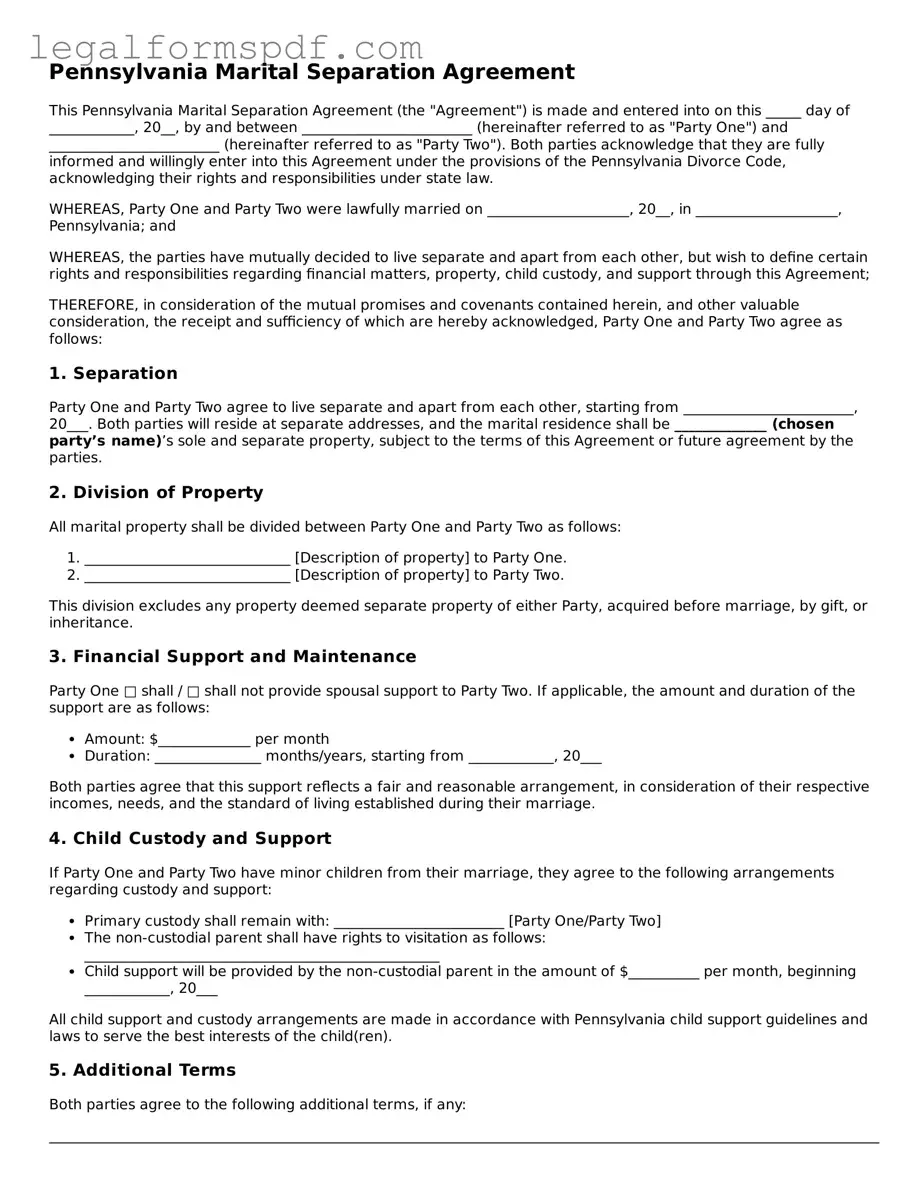Pennsylvania Marital Separation Agreement
This Pennsylvania Marital Separation Agreement (the "Agreement") is made and entered into on this _____ day of ____________, 20__, by and between ________________________ (hereinafter referred to as "Party One") and ________________________ (hereinafter referred to as "Party Two"). Both parties acknowledge that they are fully informed and willingly enter into this Agreement under the provisions of the Pennsylvania Divorce Code, acknowledging their rights and responsibilities under state law.
WHEREAS, Party One and Party Two were lawfully married on ____________________, 20__, in ____________________, Pennsylvania; and
WHEREAS, the parties have mutually decided to live separate and apart from each other, but wish to define certain rights and responsibilities regarding financial matters, property, child custody, and support through this Agreement;
THEREFORE, in consideration of the mutual promises and covenants contained herein, and other valuable consideration, the receipt and sufficiency of which are hereby acknowledged, Party One and Party Two agree as follows:
1. Separation
Party One and Party Two agree to live separate and apart from each other, starting from ________________________, 20___. Both parties will reside at separate addresses, and the marital residence shall be _____________ (chosen party’s name)’s sole and separate property, subject to the terms of this Agreement or future agreement by the parties.
2. Division of Property
All marital property shall be divided between Party One and Party Two as follows:
- _____________________________ [Description of property] to Party One.
- _____________________________ [Description of property] to Party Two.
This division excludes any property deemed separate property of either Party, acquired before marriage, by gift, or inheritance.
3. Financial Support and Maintenance
Party One □ shall / □ shall not provide spousal support to Party Two. If applicable, the amount and duration of the support are as follows:
- Amount: $_____________ per month
- Duration: _______________ months/years, starting from ____________, 20___
Both parties agree that this support reflects a fair and reasonable arrangement, in consideration of their respective incomes, needs, and the standard of living established during their marriage.
4. Child Custody and Support
If Party One and Party Two have minor children from their marriage, they agree to the following arrangements regarding custody and support:
- Primary custody shall remain with: ________________________ [Party One/Party Two]
- The non-custodial parent shall have rights to visitation as follows: __________________________________________________
- Child support will be provided by the non-custodial parent in the amount of $__________ per month, beginning ____________, 20___
All child support and custody arrangements are made in accordance with Pennsylvania child support guidelines and laws to serve the best interests of the child(ren).
5. Additional Terms
Both parties agree to the following additional terms, if any:
_____________________________________________________________________________________________________________________
6. Entire Agreement
This Agreement constitutes the entire agreement between Party One and Party Two concerning their separation and supersedes any prior agreements, whether oral or written. Any amendment to this Agreement must be in writing and signed by both parties.
7. Governing Law
This Agreement shall be governed by and construed in accordance with the laws of the State of Pennsylvania, without regard to its conflict of law provisions.
IN WITNESS WHEREOF, Party One and Party Two have executed this Pennsylvania Marital Separation Agreement as of the date first above written.
Party One Signature: ____________________________________ Date: _______________
Party Two Signature: ____________________________________ Date: _______________
